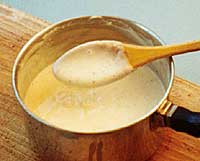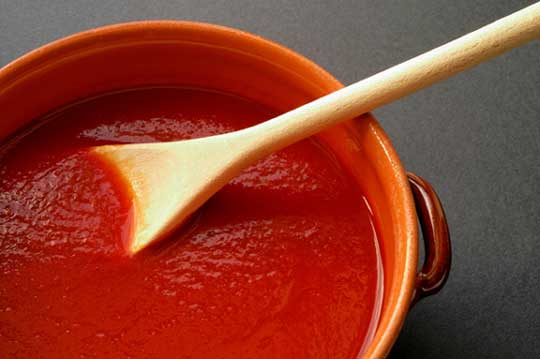Myth #2:
I am too hungry to cook! When I walk in the door, I know Marie Callender will satiate my tummy grumblings in 5 1/2 minutes. Why cook when I have Marie?
If you use this myth as an excuse, I am going to be nice and refrain from calling you "lazy." I will just simply say that you seem to be motivationally challenged when it comes to cooking (Princesses are nothing if not tactful). You may just be busy or perhaps you are not that great at planning ahead (just being honest). I get it.
When I eat dinner, I have a classically trained chef readily available to cook for me (so what if it is me). I obviously love to cook and love the experience of both feeding myself and nourishing other people's bodies and souls. However, I do understand that sometimes you are just plain old hungry and need a quick fix. I know that almost crack addict like urge to reach for a Wendy's #6 when it feels like your stomach just might implode if you don't put something in it. Indulging your cravings for food in fingertip reach every once in a while is not bad. This blog is a safe place and you will not find any shame throwing here (not much at least). However, if you find yourself eating every meal either out of a box from your fridge or from a drive through window, it is time to enroll in the Princess Eating Academy (PEA for short). Participation is highly recommended before you start seeing Marie and Wendy show up on your thighs.
Don't pay too much attention to the fact that I just made up PEA on the spot or that you just may be the first participant. The important part is that you learn how to kick your own lazy booty off the couch and into the kitchen by learning how to cook in a way that fits into your lifestyle. There are three key areas that will help you into recovery from your slothful fingertip food habit.
 P: Prep in Advance
P: Prep in AdvanceIf you chop, marinate, or otherwise prepare your food in advance, you could beat Marie's cooking time and have a healthy, home cooked meal. For example, if you are planning to make a one pot meal, like the Braised Chicken Legs and Thighs in the Myth #1 blog entry, the mirepoix can be chopped in advanced, refrigerated and then just thrown in when you are ready to cook.
Another great option is to purchase a family size package of meat, like chicken breasts, and marinate each breast individually in a ziplock bag overnight in the fridge. Once they are done marinating, you can toss them in the freezer and then defrost and cook them when you are ready. Ladies and gentlemen, you have just created your own frozen meal, no Marie needed. A great chicken marinade to use is lemon juice, white wine, garlic, cilantro and cayenne pepper.
If you are good with eating leftovers, make food in large batches on the weekend and just eat your readily made food during the course of the week. Lasagna, casseroles, pot roasts and meat loaf are great things to make in larger quantities that will last well through the week. As soon as you come in the door, just plate the food, pop it in the microwave and you are ready to go. I bet you could do that in less that 5 1/2 minutes. Take that, Marie!
The best part about cooking your own food is that you know exactly what has gone in it. You don't have to read a package full of ingredients you can't pronounce. You don't have to pretend you didn't just read that the meal you are about to eat has enough sodium to last you for a month. You also don't have to feign casual ignorance of the high calorie count of the McDonald's hamburger currently making its way to your mouth. You can eat healthy food that doesn't have unnecessary hip baggage included as a mandatory side dish.
 E: Eat small meals throughout the day
E: Eat small meals throughout the dayThe old school way of eating is three square meals every day. That worked for many generations. The problem in our contemporary world is that our sedentary yet hectic lifestyles, combined with easy access to food low in actual nutritional value, has made the old way of eating obsolete. Many dietary experts recommend breaking up your large meals into smaller meals throughout the day, which means you should snack. No Mr. Sneaky, I am not talking about snacking on Mike & Ike's (my favorite candy), the McDonald's Dollar Menu or Starbucks Frappuccinos. Those are all full of empty calories that neither provide much nutrition nor do they give you the energy to tackle your busy day (not to mention the fact that their culinary artistry is so low it isn't even on the scale.)
Try packing fruit (fresh or dried), nuts, boiled eggs and veggies along with your lunch for work. You can even take it back to childhood and get creative with fun snacks like ants on a log (celery with peanut butter and raisins). Snacking will help you stay healthy and should feed the hungry beast in your stomach so you aren't so ravaged when you get home.
A: Accurately manage lifestyle expectations
Let's be realistic. You aren't going to change your eating habits over night. Why set yourself up for failure by kicking Marie out of the freezer on Monday and expect to eat only organic, whole grains by Tuesday? Think of quitting fingertip food like quitting smoking. People who ditch the cancer sticks cold turkey are usually less successful than those who slowly wean themselves off their addiction. However, there are multiple ways to slow the fast food hemorrhaging to a trickle.
We aren't talking about cutting down your burger ration from 7 a week to 2 (although that would be a great start). How about transitioning to healthier burger options and finally cutting back to having fast food be a treat rather than your gastronomic norm? Not a fast food junkie, but you can't seem to eat anything unless it comes in a plastic dish from your freezer? Put down the Hungry Man Dinners and pick up healthier options such as Kashi, Amy's, or Trader Joe's frozen meals. These healthier options are lower in sodium, have better portion control and contain more organic and natural ingredients. Plus, in my humble opinion, they taste A LOT better. Keep in mind, even healthier frozen meals should just supplement your growing cooking adventures.
Congratulations on taking the first steps in your PEA program! I wish you the best of success as you strive to cook more and eat better.
Although not part of the PEA program, there is yet another healthy option: Micro-Catering by Culinary Princess Catering. You can have a classically trained chef cook your meals for the week and deliver them. Not only are the meals catered to your specific health and dietary requirements, but the food tastes fantastic. Micro-Catering is convinient, healthy and scrumpdidlyumptious!
Thanks for working with me to debunk yet another myth and remove a harmful excuse to why you can't cook.
Next Time: Myth #3 "Cooking for myself and family is too expensive! Don't you know we are in a recession? Well, if you don't get it, McDonald's understands. Why else did they invent the Dollar Menu?"
























